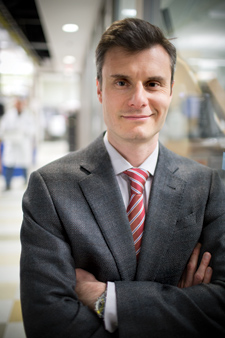Early Detection to Beat the Odds
New screening technologies developed by McCormick's Vadim Backman hold promise for dramatic changes in the diagnosis and treatment of cancer
In 1928, Georgios Papanikolaou, a Greek physician, made a discovery that would forever change the practice of women’s health. After gathering cells from an easily accessible area, he found he could examine them under a microscope and detect early signs of cervical cancer. Soon, physicians worldwide began administering the “Pap test” during routine patient visits. Early diagnosis naturally led to early treatment, and cervical cancer death rates dropped by 90 percent.

“If we only had regular comparable screens for other types of cancer—lung, colon, and prostate, for example—we could reduce cancer deaths by ten fold,” says Vadim Backman, Walter Dill Scott Professor of Biomedical Engineering at McCormick. “But when else have we seen such a discovery? Never.”
Backman hopes to change that. He has developed a new suite of tools for early cancer detection and diagnostics that could potentially rival the monumental impact of Papanikolaou’s test. The abnormalities that Papanikolaou noticed were clearly revealed beneath the microscope; Backman’s test can detect changes that occur even earlier and on the smallest scale.
The new technologies that Backman has developed have one common denominator: they provide information about the structure and function of tissues at the nanoscale level. Catching pre-cancer at this early stage—when small dysfunctions just begin to percolate within the cells—could possibly lead to treatment before the formation of tumors and the aggressive spread of disease.
RACE AGAINST TIME
“If you look closely at the nature of cancer research throughout the world, greater than 90 percent is focused on tumors,” Backman says. “The question we’re asking in our research is very different.”
A vast treatment gulf separates stage four cancer, which is almost untreatable, and stage one, where survival is close to 100 percent. The problem is that early-stage cancers rarely exhibit symptoms, so physicians have no indication to treat them. That’s why, Backman says, early screening and diagnosis are the only ways to win the war on cancer.
Backman’s potentially life-saving technology, called nanocytology, works by harnessing the power of light to examine cells from easily accessible areas of the body. A simple swab of cells from one area, such as the inside of a cheek, can uncover malignancies in a nearby organ, such as the lungs.
“For the first time in history, we have a chance to make a real dent in cancer. This isn’t a fantasy; this is very real.”
—Vadim Backman
When researchers shine light onto the harvested cells, photons bounce off the nanostructures within them. The different angles of scattered light tell a story about the health of cells, which upon analysis can lead to an accurate diagnosis at even the very earliest stages of cancer formation. Using these bio-optic techniques, Backman can detect details indicative of “pre” pre-cancer, something that formerly could not be done with conventional microscopes.
PROTECTION THERAPIES
“Early detection is the way to go,” Backman says. “But there are people who have cancer right now, and they need therapeutics.”
Functional changes that are not well understood happen in early stages of cancer. Backman’s work has given the community a fuller understanding of what happens during cancer formation. It has also illuminated pathways for new therapeutic targets.
Backman is particularly interested in chromatin, a macromolecule that resides within a cell’s nucleus and controls gene expression. “If proteins and DNA are the tools that make our bodies work, then chromatin is the hand that chooses the tools,” he says. “For cancer to arise, genes must become altered, mutated, or expressed. The only way for this to happen is for the chromatin to allow it. That’s what drives the cancer.”
Instead of battling the outcome of gene expression, Backman wants to thwart dysfunctional gene expression before it happens. He has developed a nanocytology technique that, for the first time, allows researchers to look at chromatin in living cells without toxic stains or labels and is working on ways to control the chromatin in order to prevent it from causing cells to become cancerous.
MAKING A REAL DENT
Such new therapies might lie down a distant road, but Backman’s early detection technique could soon be available for physicians to use with their patients. Several large clinical trials are already in progress, and three tests—for lung, colon, and prostate cancer, which are also the most common types—should enter the market within one to three years.
Replacing colonoscopies and prostate-specific antigen tests with Backman’s screens would make testing less invasive, less expensive, less risky, and more accurate. Backman is also developing screens for ovarian and pancreatic cancers, which will be available further down the road.
Much like the Pap test, these new screens could become a part of regular primary care so physicians would always be one step ahead of cancer, ready to prevent it from getting out of control. For example, dentists could automatically screen smokers for lung cancer during a routine checkup.
“For the first time in history, we have a chance to make a real dent in cancer,” Backman says. “This isn’t a fantasy; this is very real.”
